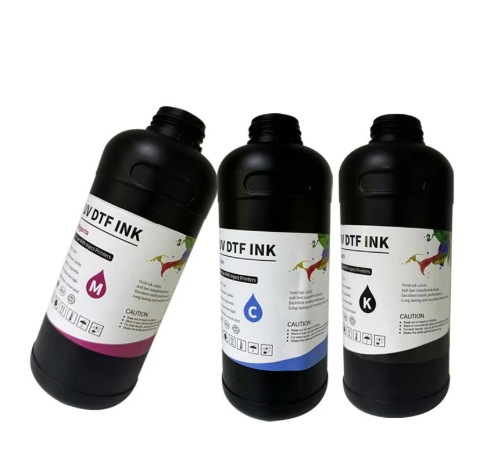Versatile Material Compatibility of UV DTF Printers
Plastics and Acrylics
UV DTF printers can handle all sorts of different materials, especially plastics such as PVC, polyester and polycarbonate sheets. What makes this possible? The special UV curable inks stick really well to these surfaces. When we talk about UV curing, basically what happens is the ink bonds properly to plastic surfaces through some pretty cool chemistry stuff happening right there on the material. This bonding creates much tougher prints than regular methods allow. For products going outside where they'll face sun, rain and general abuse from Mother Nature herself, these prints last way longer without fading or peeling off completely. That's why so many sign makers and outdoor advertising companies have switched to DTF technology recently.
Acrylic surfaces work really well with UV DTF printers thanks to their clear nature and ability to take on prints. The tech behind these printers delivers bright colors that hold up over time even when exposed to various weather conditions and won't run or fade easily. What's more, UV DTF printers can produce very sharp details which is why they're so popular for printing complex designs onto all sorts of stuff from plastic panels to acrylic displays. Businesses find this particularly useful since it opens up possibilities across multiple industries where both quality and durability matter.
Glass and Ceramic Surfaces
UV DTF printing works really well on glass and ceramic surfaces too. The tech lets people print detailed designs on all sorts of stuff, whether they want something just for looks or something that actually does something. That's why many shops choose these printers when making things like coffee mugs or bathroom tiles that need to last. What makes this possible are those special inks that come with the system. These inks stick to glass and ceramics almost instantly after printing. Most folks notice their printed items stay bright and don't get scratched easily even after months of regular use around the house or office.
Research shows that UV DTF printing lasts much longer on glass and ceramic surfaces than older printing techniques. The reason? Those special UV cured inks actually stick better to these materials, so they don't chip away or lose color over time. For people wanting to personalize household goods, this matters a lot. Think about those custom coffee mugs everyone loves, or those fancy bathroom tiles with complicated patterns that stay looking good even after years of use. When someone invests in a UV DTF printer for working with glassware and ceramics, they get products that look great initially and keep their appearance despite regular handling and exposure to different conditions around the house.
Metal and Wood Substrates for UV DTF Printing
Stainless Steel and Aluminum Applications
UV DTF printers work really well when it comes to printing on metals such as stainless steel and aluminum, which makes them pretty important for businesses looking at long term durability. The prints actually hold up against scratches and won't fade easily either, so products last much longer even when exposed to tough conditions. According to some recent market studies, we've seen around a 20% jump in demand for these kinds of printed metal goods last year alone, thanks largely to improvements in how UV printing works. People just seem to want their metal stuff to look good while standing up to wear and tear, something manufacturers in construction equipment and outdoor furniture markets have noticed especially.
Natural vs. Engineered Wood Performance
Wood works really well as a base material for UV DTF printing, both when it's straight from nature or manufactured. Real wood adds that special something to printed pieces something no two pieces look exactly alike, plus there's this warm feel to them. Engineered wood meanwhile gives printers what they need most consistency across multiple items, which matters a lot for big runs of products. The UV inks stick to wood surfaces pretty darn good too, so the colors pop and those fine details stay sharp even after handling. Some tests show that prints on certain types of engineered wood last around 10 years before showing any real signs of fading or damage. That kind of durability explains why many artists and designers turn to UV DTF printing when making lasting wall art, custom furniture pieces, or decorative items meant to stand the test of time in homes and commercial spaces alike.
Specialty UV DTF Printer Materials for Unique Projects
Leather and Textile Printing Capabilities
UV DTF tech is changing what we can do with leather and fabrics, making it possible to put really good quality prints on stuff like custom backpacks and clothing. What makes this tech special is how it actually works with different material surfaces instead of fighting against them. The ink sticks well even on tricky textures without peeling off after a few washes or wears. One big plus is those UV inks that let designers create detailed patterns and bright colors that look great on everything from smooth leather jackets to rough canvas tote bags. Print shops around the country have started adopting this method because customers want their gear to stand out these days. We're seeing whole new markets open up as people realize they can get truly unique products made right here locally instead of settling for mass produced options.
Customized Phone Cases and Tech Accessories
People love putting their own spin on phone cases and other tech gadgets these days, and UV DTF printing makes it possible to get really detailed custom designs. What's great about this method is that it works on all sorts of plastic materials, so businesses can create products that fit individual preferences down to the last detail. Market research indicates something interesting too the customization sector for mobile accessories is expected to boom over the next half decade. Why? Well folks just want stuff that looks like them, and UV DTF tech keeps getting better at making those personal touches happen across various materials. As companies adapt to what customers want, we're seeing entire markets transform around this growing demand for one-of-a-kind items.
Handling Complex Shapes with UV DTF Technology
Cylindrical Objects: Bottles and Tumblers
UV DTF tech has changed how we print on round stuff like bottles and tumblers. Special methods make sure the ink covers all those tricky curves without missing spots. What's great about this setup is that it works across different sizes while keeping the fine details intact. That makes it perfect for things like company giveaways or birthday presents where people want something special. More folks are asking for custom drinkware these days, which means there's real money to be made here if businesses get their hands on UV printers. People just love having something that stands out from mass produced goods, so companies investing in cylindrical printing now are probably looking at some serious growth down the road.
3D Textured Surface Printing Techniques
New developments in UV DTF tech now let designers print on all sorts of 3D textured surfaces, giving their creations real depth and dimension. Businesses in various fields including art supplies, home decor, and packaging can offer customers something truly special thanks to this breakthrough. According to industry reports, we're seeing more and more companies adopt these textured finishes for everyday items, showing just how big of a deal 3D surface printing has become in recent years. What makes this so exciting is that it gives manufacturers fresh ways to stand out in crowded markets while creating products people actually want to touch and interact with.
Material Considerations for Optimal UV DTF Results
Surface Preparation Best Practices
Getting the surface ready right matters a lot for good adhesion and quality prints when working with UV DTF tech. Cleaning off dust, giving surfaces a quick sand if needed, or applying primer all help the UV ink stick better to whatever material we're printing on. Choosing materials that actually work well with UV inks makes a big difference too. Some plastics just don't take UV ink properly without special treatment first. People who have been around printing shops know this stuff inside out. They'll tell anyone willing to listen that taking time to prep surfaces properly isn't just about following rules - it literally makes the prints last longer. A properly prepared surface means colors stay bright and sharp instead of fading away after just a few weeks.
Durability Across Different Material Types
UV DTF prints stand out because they last really well on almost any kind of material, giving them an edge in both what people buy for themselves and what gets used in factories. How long these prints will hold up depends on a few things like what kind of ink was used, what surface it's printed on, and where the finished product ends up sitting around. Lab tests have shown that UV DTF prints handle sunlight exposure, get wet without fading, and take punishment better than most other printing techniques out there. That makes sense why so many businesses choose this method when they need something that won't fall apart quickly. The colors stay bright too even after months or years of being displayed, which matters a lot for products that need to look good over time.
Frequently Asked Questions
What types of materials can UV DTF printers print on?
UV DTF printers can print on a wide range of materials including plastics, acrylics, glass, ceramics, metals such as stainless steel and aluminum, wood (both natural and engineered), leather, textiles, and even complex shapes like cylindrical objects.
Why are UV DTF prints more durable than traditional prints?
UV DTF prints are more durable because the UV-curable inks bond robustly with the substrate upon curing, providing excellent resistance to UV light, moisture, and wear. Additionally, proper surface preparation further enhances this durability.
What are the typical applications of UV DTF technology?
Typical applications include promotional items, home décor, personalized gifts, mobile phone cases, tech accessories, and customized drinkware. The technology is also used for printing on leather, textiles, and complex 3D surfaces.

